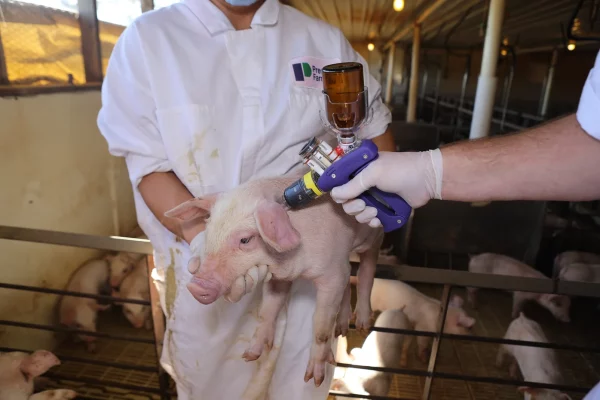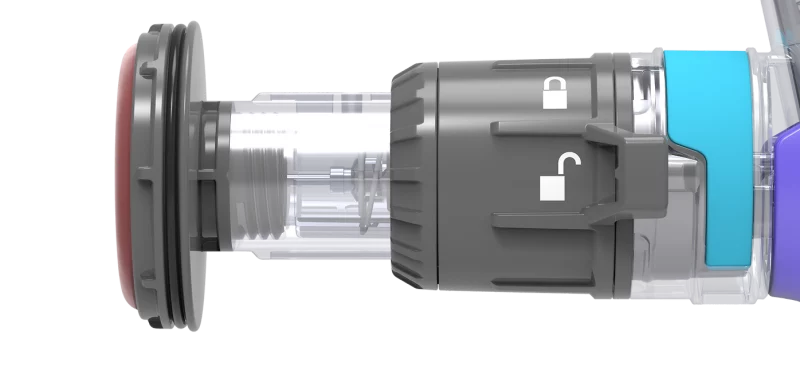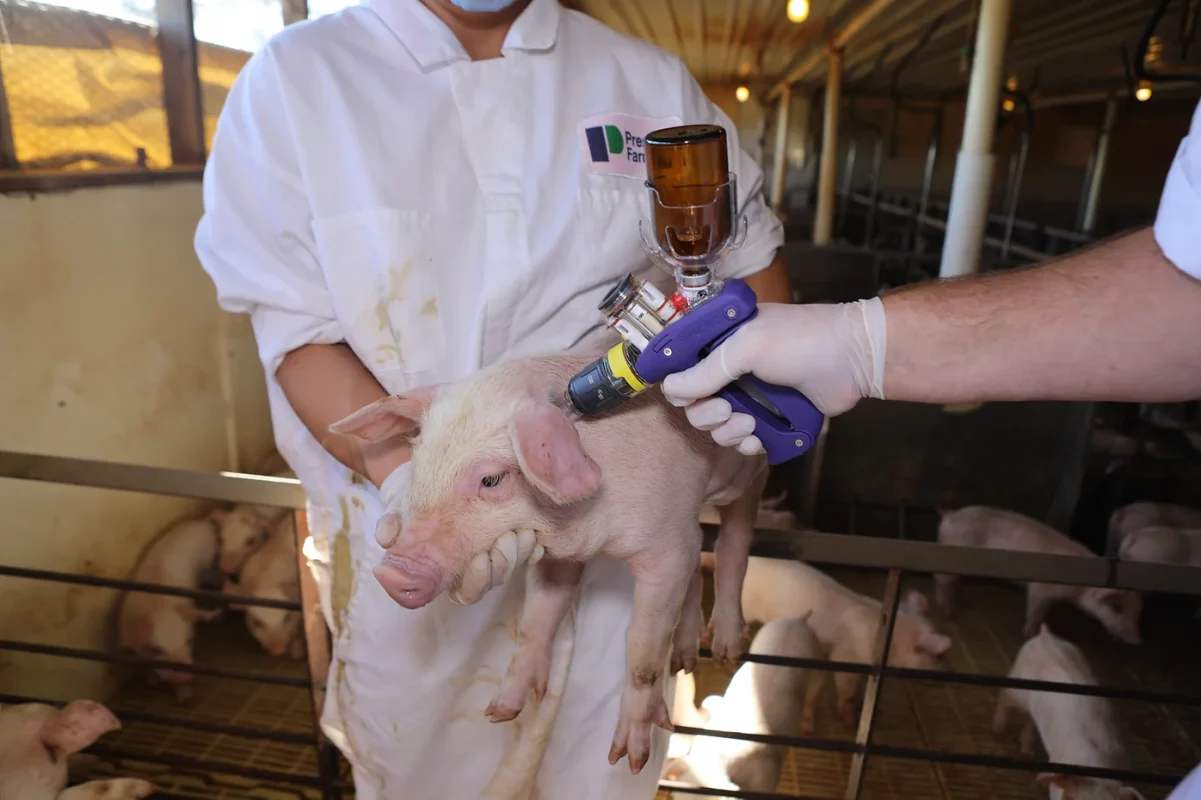Tags
Safer Pig Vaccination

Pig producers in the UK face a diverse range of disease challenges and with 40% of the national herd outdoors, rearing units have diverse challenges so individual farm specific solutions for disease prevention and control are essential. They largely focus on good biosecurity, husbandry, nutrition and a robust herd health plan, to prevent and control disease. However, a significant cornerstone of this is a strong vaccination strategy to protect breeding pigs, piglets and growing pigs from the main pig disease groups.
Vaccinating groups of animals also offers the protection of ‘herd immunity’ where the overall disease challenge can be lowered. This leads to long-lasting prevention of disease and less reliance on antimicrobials which is becoming an increasingly important factor in ethical and sustainable pork production. AHDB report the amount of antibiotics prescribed to treat pigs on UK farms in 2020 fell by 5%, bringing the total reduction since 2015 to 62%. A further reduction target of 30% by 2024 requires strong antibiotic stewardship by veterinary and farming bodies.
Another challenge to the pig industry is the removal of zinc oxide as a treatment for diarrhoea by 2022 in line with EU regulation. Post-weaned pigs can be susceptible to this and optimising gut health, good biosecurity and colostrum management are all preventative measures (Source; AHDB).
Vaccines at different life stages depends on the particular risks encountered at that time. Vaccines when given to pregnant pigs offers protection either to the unborn piglets or to the new-born piglets through colostrum which is also a key husbandry practise ensuring piglets receive adequate quantities. Vaccinating pregnant sows or gilts against Porcine Parvovirus (PPV), which can cause a range of reproductive problems including death of piglets before they are born has been a cornerstone to controlling PPV and has proven to be highly effective (Source; NOAH).
Another common infectious disease that can also be controlled by vaccination is Erysipelas – seen in large and small holdings alike. Erysipelas is a bacterial disease with a variety of clinical signs including skin lesions, arthritis and blood poisoning with death sometimes a result. Vaccination once again has proven key in disease control which can be picked up from the surrounding environment and a variety of sources (Source; NADIS).
Immunosuppressive disease in pigs can increase the complexity of diseases seen on farms by predisposing pigs to mixed infections when their immune response is suppressed. An example is Porcine Reproductive and Respiratory Syndrome (PRRS) which has become a problem for many herds in recent years affecting pigs of all ages and in young piglets scours and weakness in particular lead to high mortality rates (Source; NOAH).
Many producers prefer to vaccinate small pigs around weaning time, as they are individually handled regularly. This is usually around 3 to 6 weeks of age. However, there can be a preference to spread out the stress that comes from weaning and vaccinations, and consider vaccinating a few days after the pig has been weaned. When weaning pigs at older ages, vaccination may be required prior to weaning to ensure sufficient disease prevention coverage is achieved. This can also be dependent upon the disease pressure that exists in the herd. Combination vaccinations are a good choice in particular for show pigs eliminating the need for multiple injections, reducing stress and the possibility of swelling or injection site lesions developing on the pig.
Erysipelas vaccinations should not be given before six weeks of age. Research suggests that the maternal antibodies that are transferred to the pig via colostrum and milk may affect the vaccine if it is given too early (Source; NADIS).
Occasionally pigs can receive an adverse reaction to a vaccine which has been administered. Instances include;.
-
Cold shock – especially in young piglets if given straight out of the fridge. Consider warming before use to body temperature before administration (but store correctly in fridge beforehand).
-
Accidental injection into an artery or vein. (The reaction in both cases is instant and normally temporary, with recovery in 10-15 minutes).
-
Allergic reaction. Very rarely this will occur after multiple vaccinations, within one hour of application and sometimes be fatal.
-
Abortion. With modern vaccines licensed for use in pregnant animals (e.g. E.coli, Erysipelas, PCV) abortion is rare. Previous contamination of a part-used bottle is often to blame.
-
Rarely, young piglets will react to the other chemicals included in vaccines (adjuvants) and may vomit and collapse. Death can occasionally occur. Source; (NADIS)
In addition to reactions in pigs, vaccinating crews must be particularly aware of the very real danger of needle stick injury. The Upper Midwest Agricultural Safety and Health Center (UMASH) in the USA report more than 80% of farm workers and 73% of swine veterinarians working in animal agriculture have accidentally stuck themselves with a needle. Needles are typically used multiple times and can become contaminated with skin or faecal organisms which result in an infection if injected accidentally into a human. Some vaccines (for example, a live Erysipelas vaccine) could cause a local infection if accidentally injected into a human (Source; UMASH).
Some vaccines are made with agents designed to enhance the immune response, called adjuvants. Adjuvant containing vaccines, typically known as “killed vaccines,” are very irritating and can cause inflammation when accidentally injected into a human. Female workers should also take extra care due to the nature of some of the treatments administered affecting menstrual cycles, reproductive issues and pregnancy (Source; porkgateway.org).
Where any incidents occur, urgent medical attention should be sought (preferably Hospital Accident and Emergency) and you should take the data sheet (SPC) of the product with you.
Another occurrence the pig industry takes great strides to prevent is broken needles which is a rare event but serious for consumer food safety, animal welfare and processing plants who often utilise metal detectors to safeguard production lines and preventing any risk of entry into the food chain. Bent needles should never be straightened and reused. Replaced instead with a new needle which should be regularly changed and safely disposed of into a sharps box. The rare incidence of a broken needle often starts with a bent needle which is straightened or unnoticed, which then leads on to a breakage. This can be prevented with devices incorporating needle guards that quickly reveal such an incidence. They also protect the user from needle stick injuries occurrence too.

The Simcro™️ VS Injector has been designed from the ground up for compliance and safety . The VS injector can be matched to on-farm treatment protocols with accurate, in-built fixed dose volumes and coloured identification bands. The interchangeable needle guard minimises accidental needle stick injuries for operator safety and reduces the chance of needle breakage. With biosecurity being paramount, the entire injector can be boiled or disinfected to comply with on-farm hygiene regimes.
The VS injector also incorporates an optional, specially developed, interchangeable Ink Stamp marking system, allowing vaccination crews to visibly identify treated animals – and managers to maximise animal welfare and treatment efficacy, by checking the injection has been administered in the correct location.
The Injector has also been ergonomically designed to be a balanced and efficient device that can be used comfortably over extended periods of time and the entire injector can be boiled or disinfected to comply with on-farm hygiene regimes.
Check out our range of Simcro products here!


